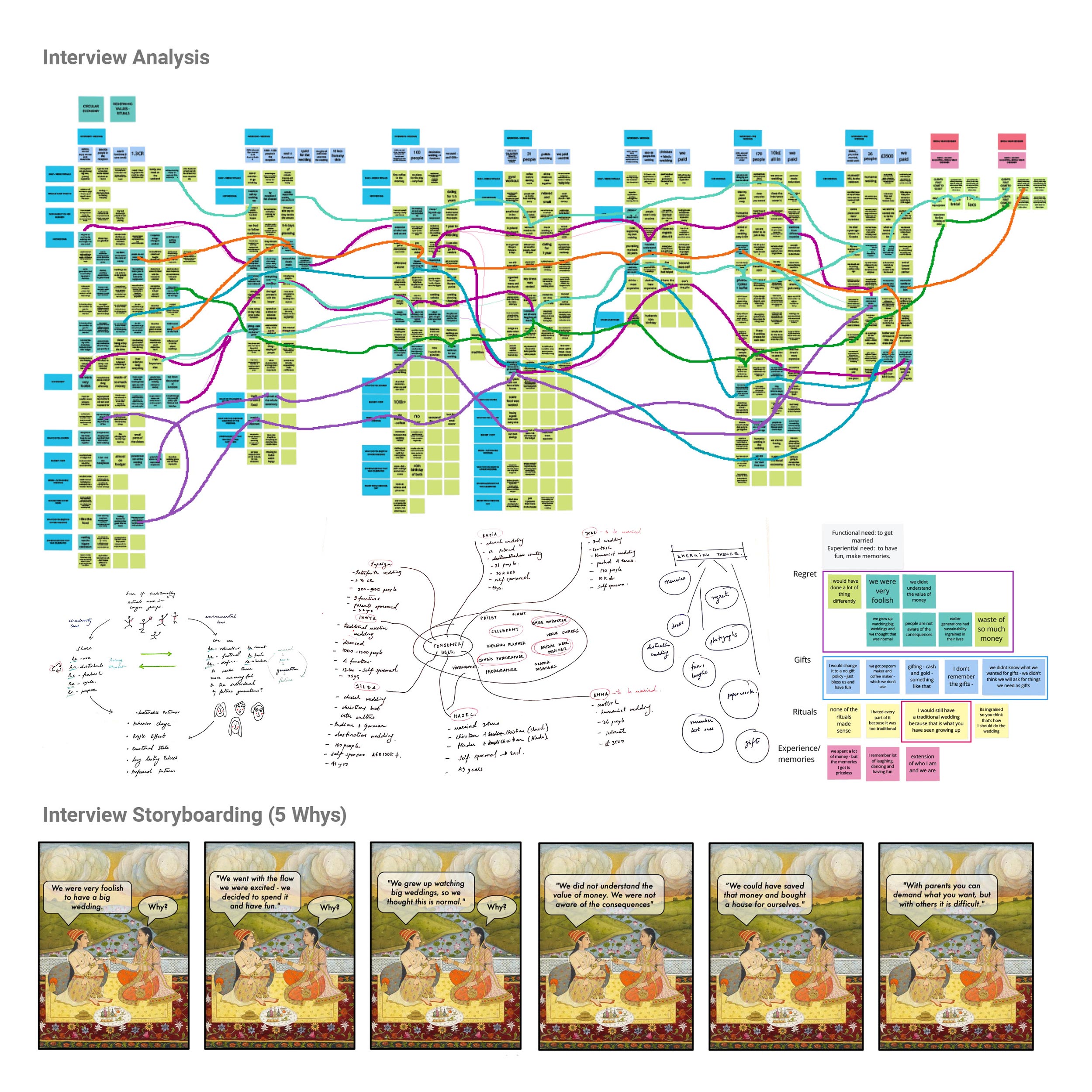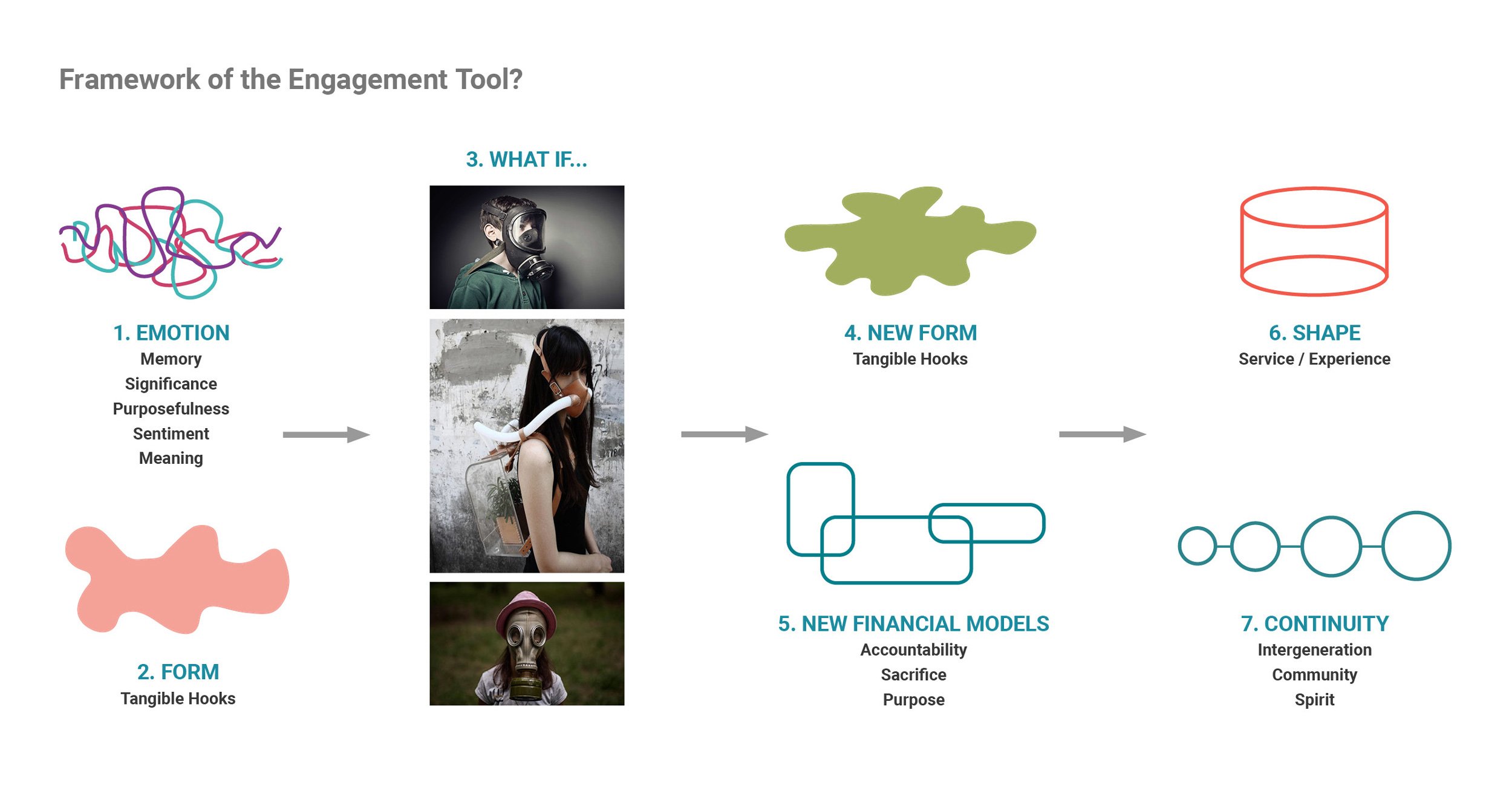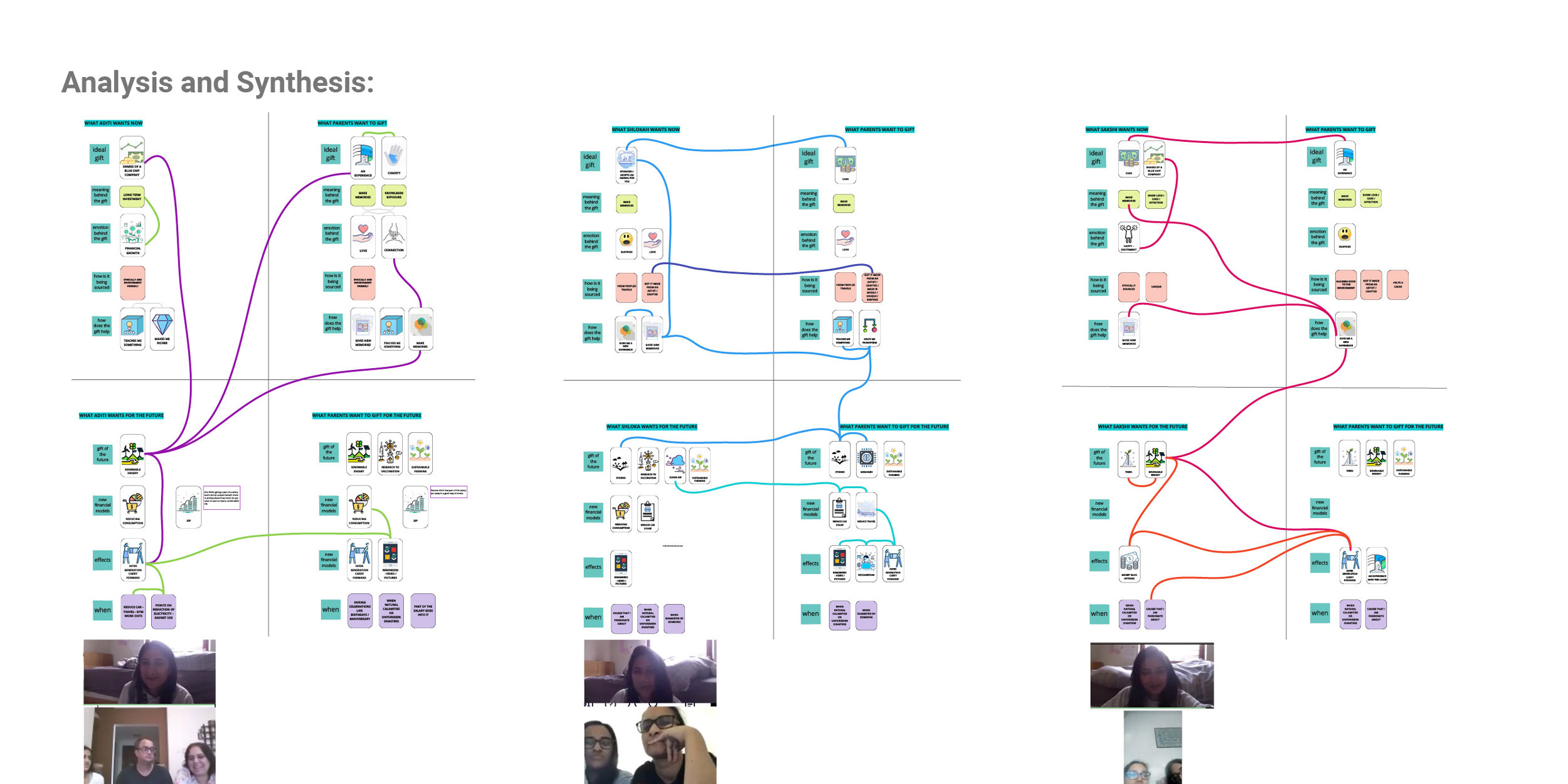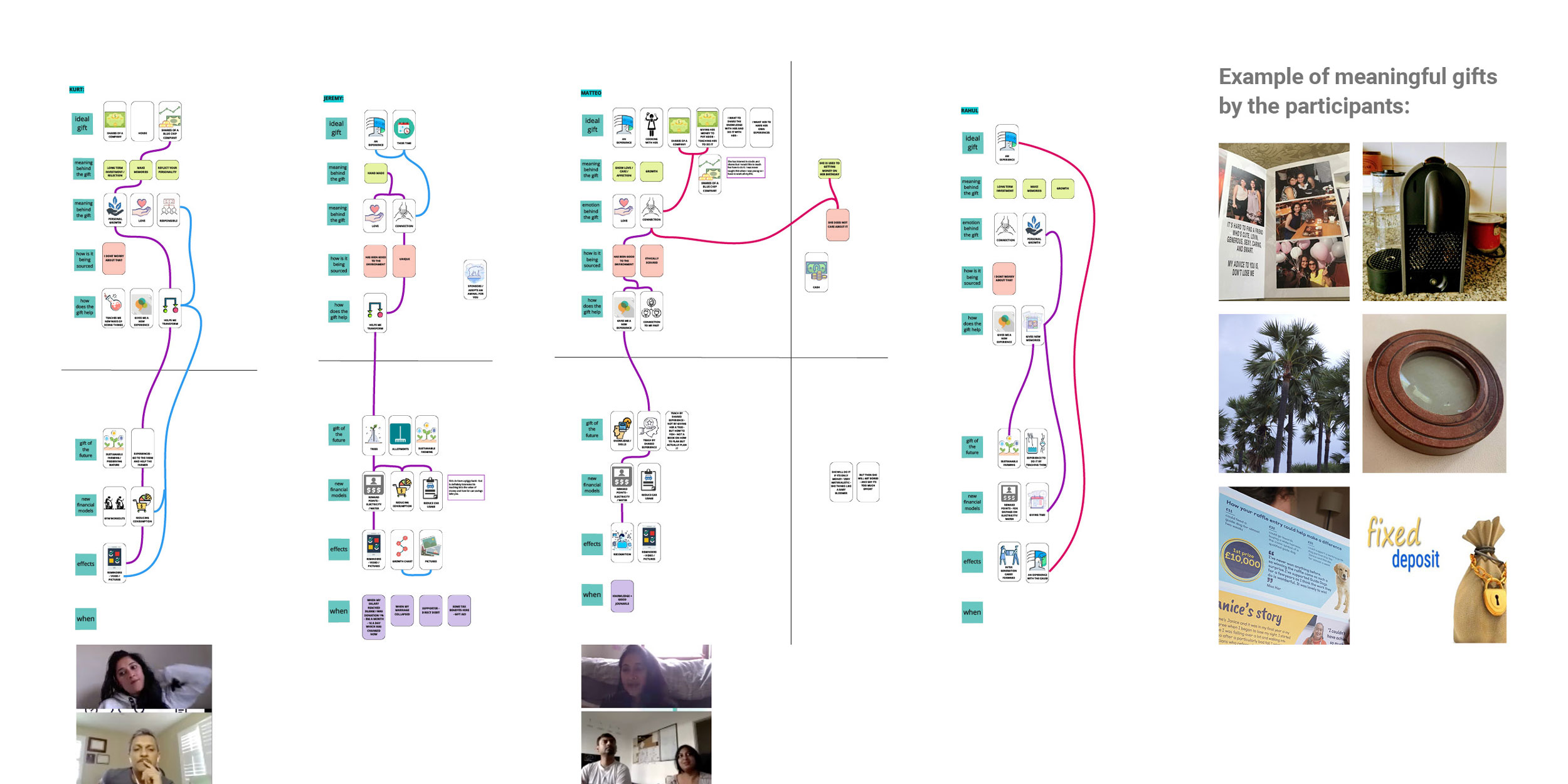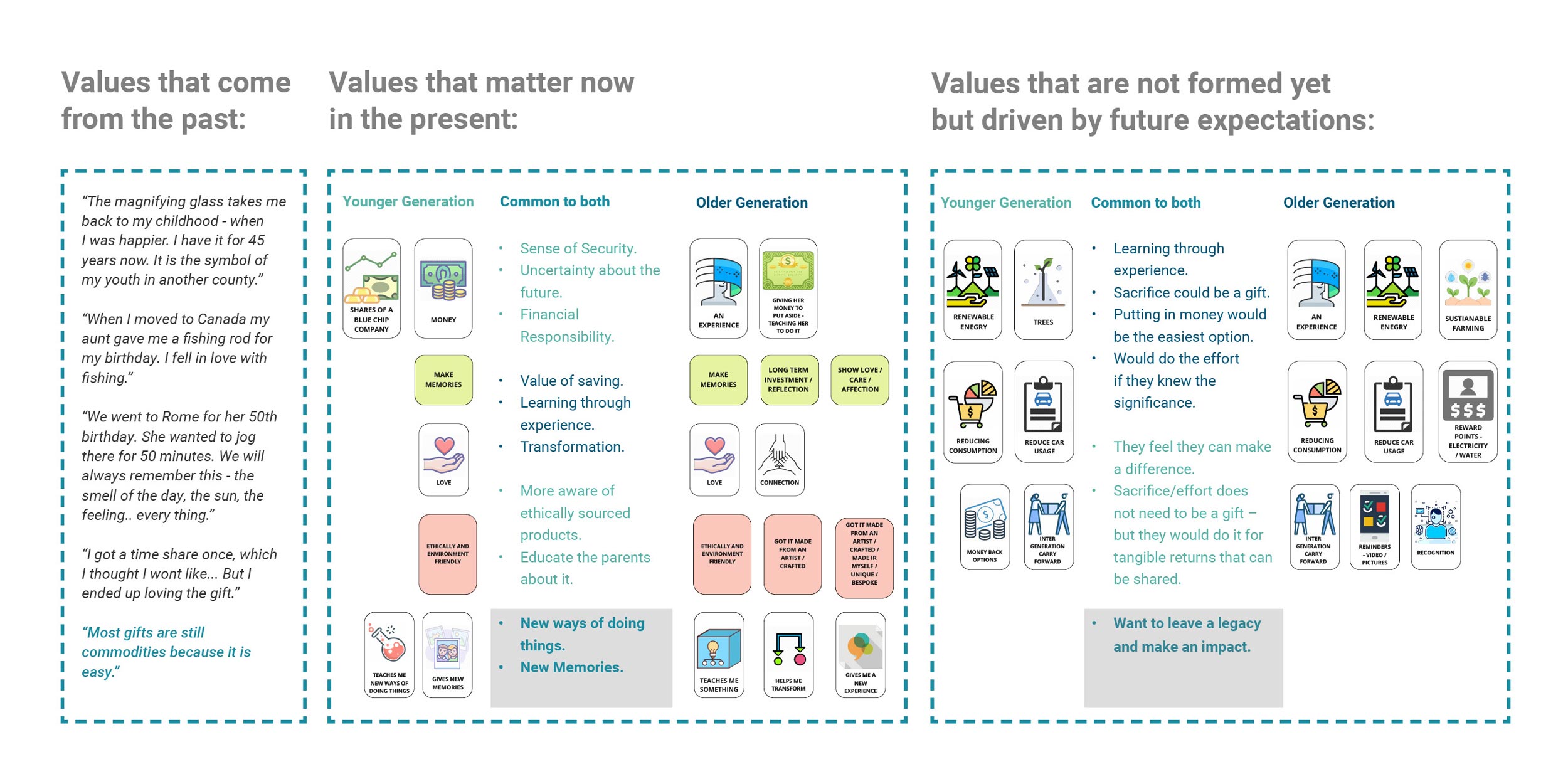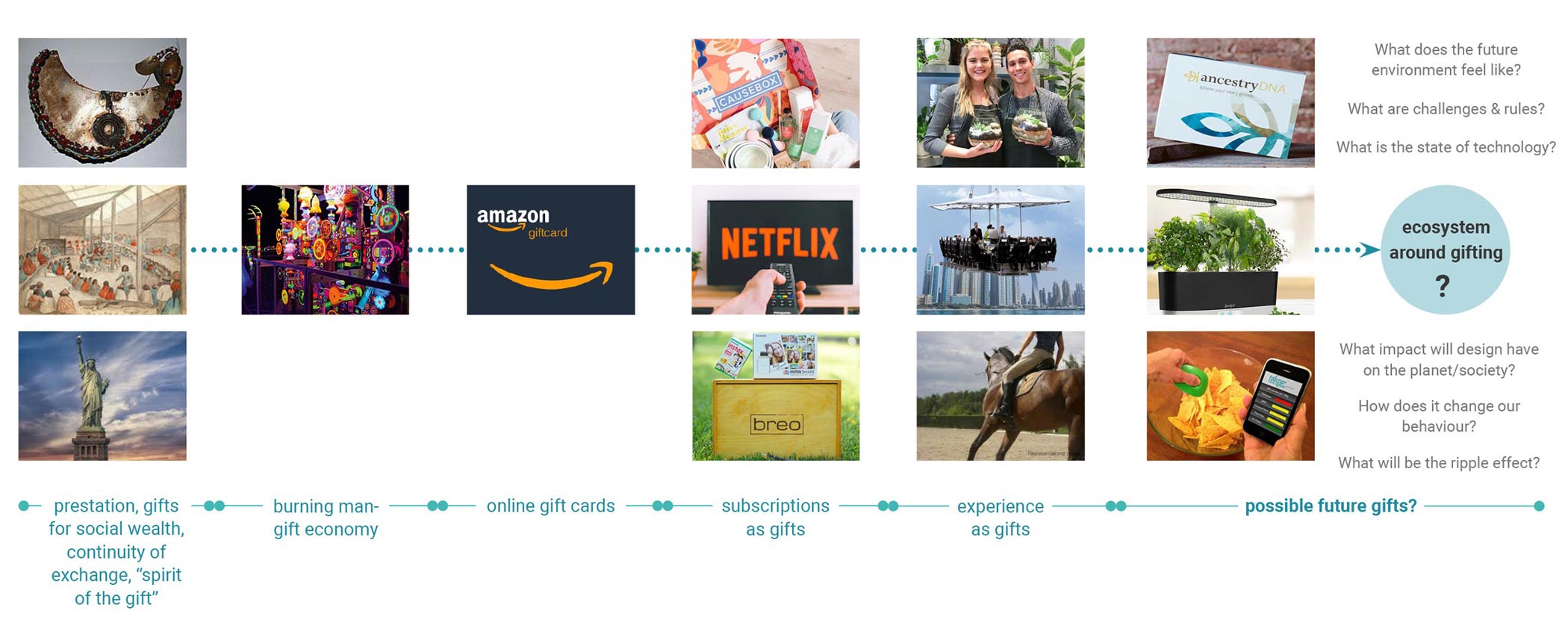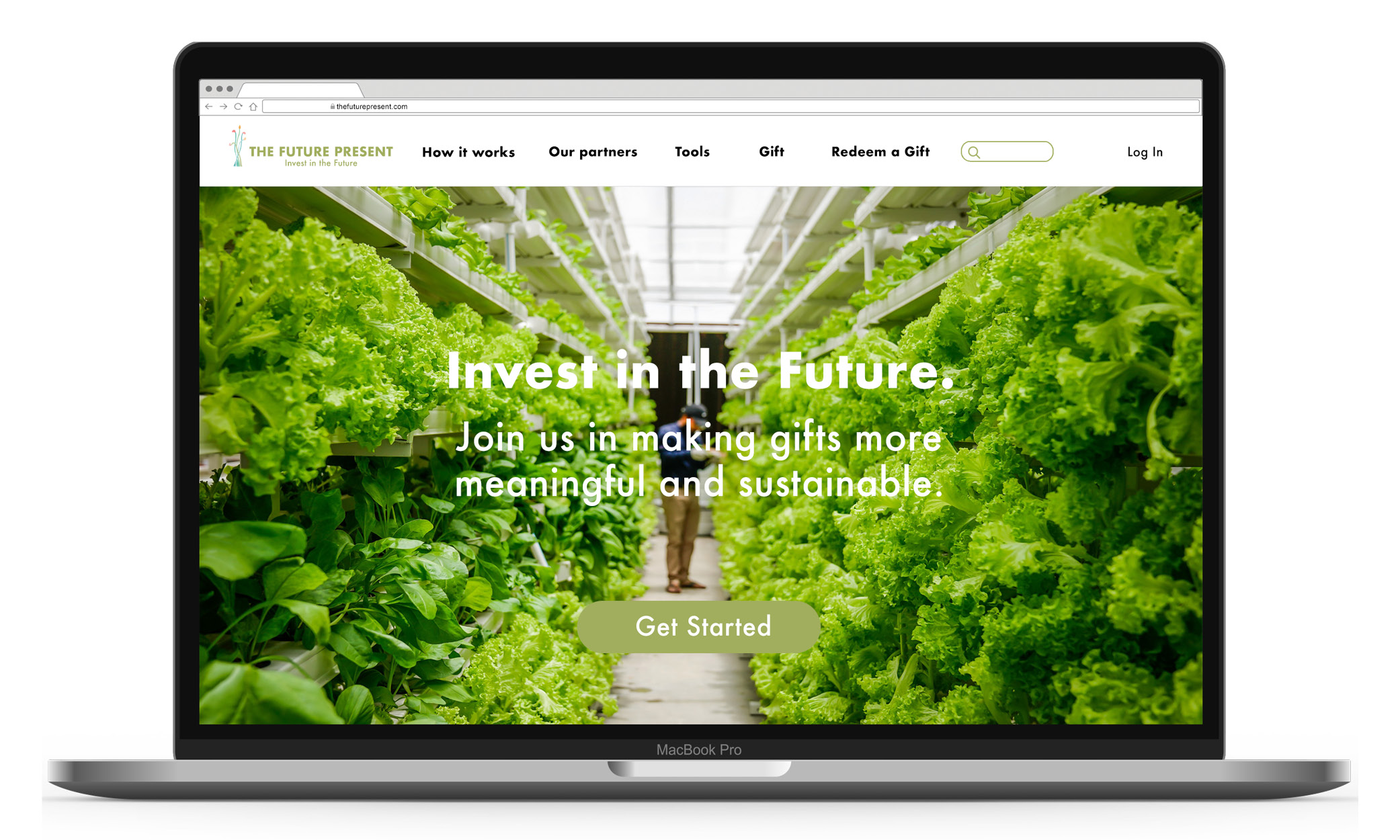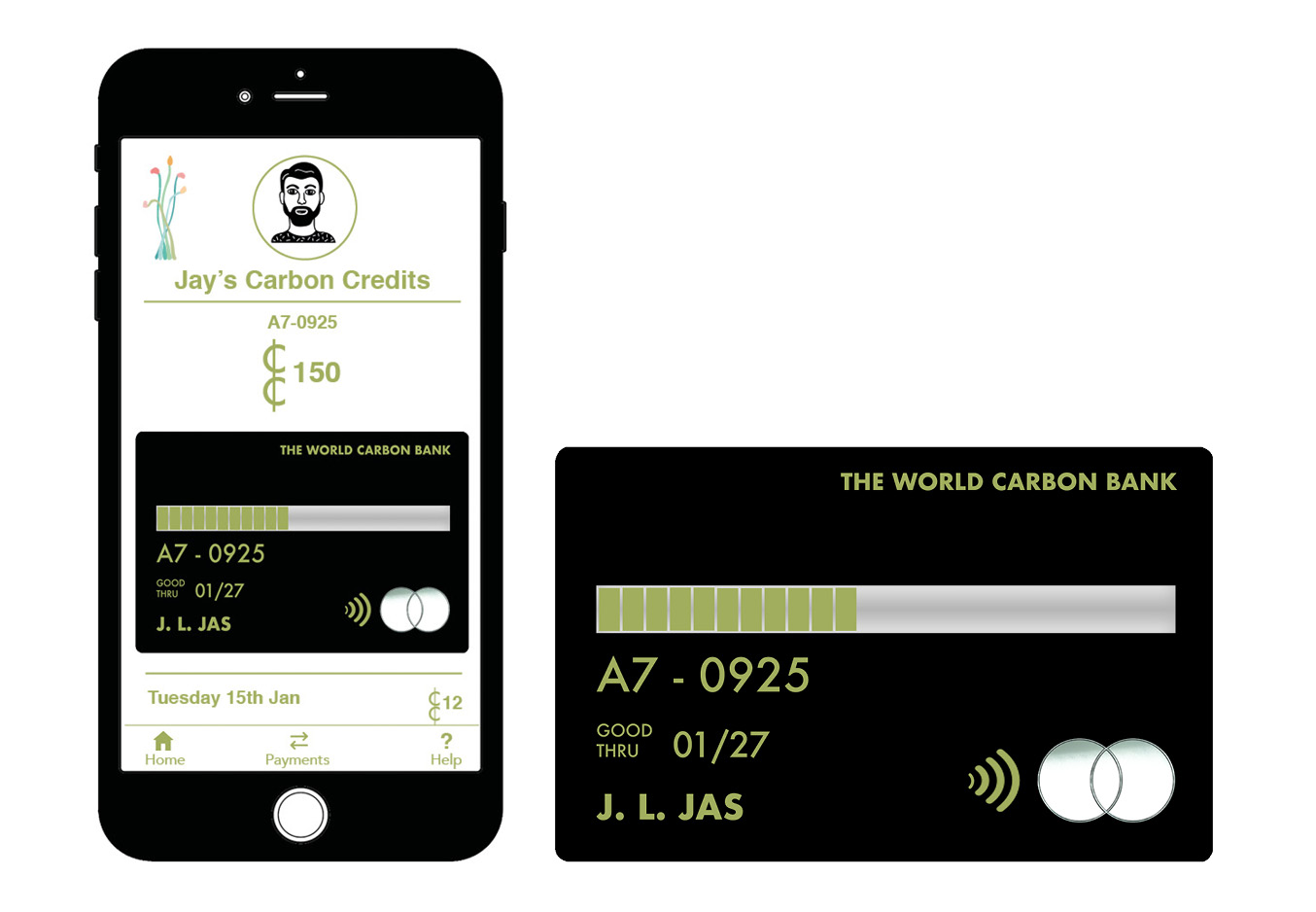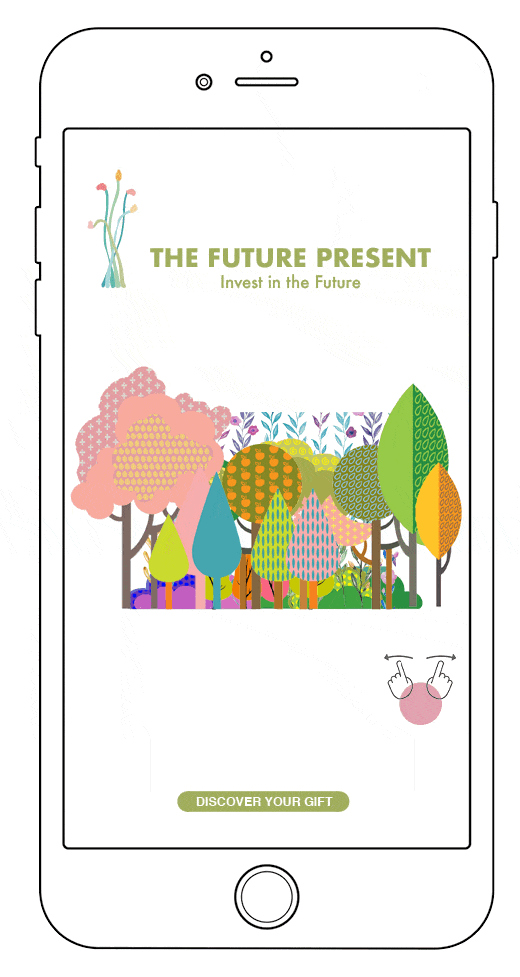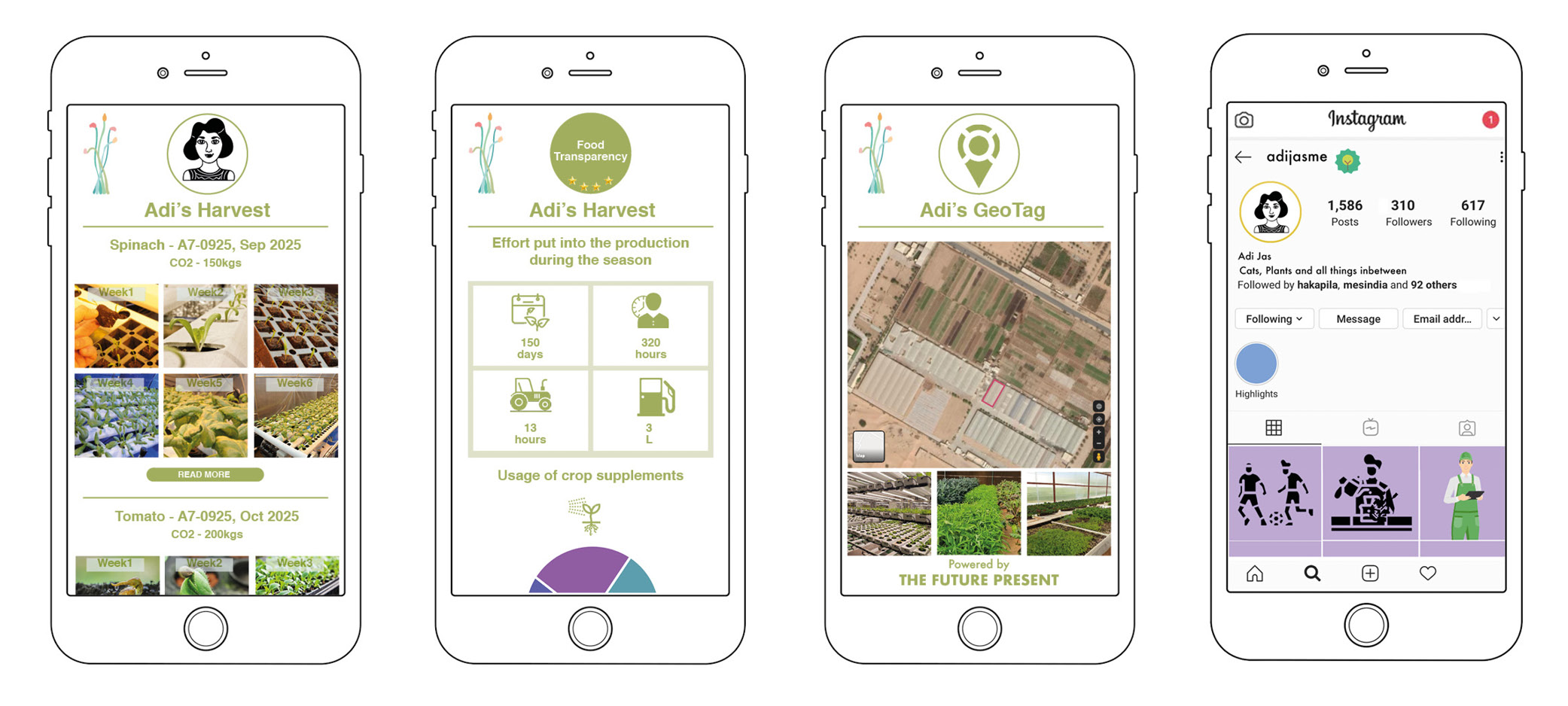The Future Present: Reimagining Gifting
Objective: The goal of the project was to explore the power of rituals to nudge changes in collective individual attitude/behaviour, to be more ecologically responsible, synonymous with the emerging future, and towards results we don’t see immediately.
Process: Desk Research, User Research, Interviews, Engagement Tools, Synthesis, Insights, Ideation, Participatory Design, Prototype, Concept Directions, Feedback and Iteration, Expert Interviews, Storyboarding, Stakeholder Mapping, Writing, Final Video, and Presentation.
Solution: An online web-/App-based service that allows parents to make micro-investments for or on behalf of their children, towards sustainable projects, and package these micro-investments as gifts.
Learnings: Rituals and traditions are important to people even if they don’t fully understand them. Services like rituals should create the extraordinary out of the ordinary, add value to people’s lives, create meaningful experiences and serve an extended purpose though out a customer’s life.
Time: 10 weeks
Role: Service Designer, Design Strategist, Customer Experience Designer
Secondary Research
Methods used
Reports, Research Papers on Ritual Studies, Intent Statement, Johari Window Model Analysis, Popular Media Search, Research Mapping, Interest Group Discussions, Focus Group Discussions.
I started my desk research by getting a basic understanding of rituals, their function, and their role (historically and presently) in our everyday lives. Moreover, it was important to distinguish them from ‘routines’ since the two are regularly used to mean one another. However, there is one important difference: one of them is done with an intent or purpose to make meaning, the other doesn’t.
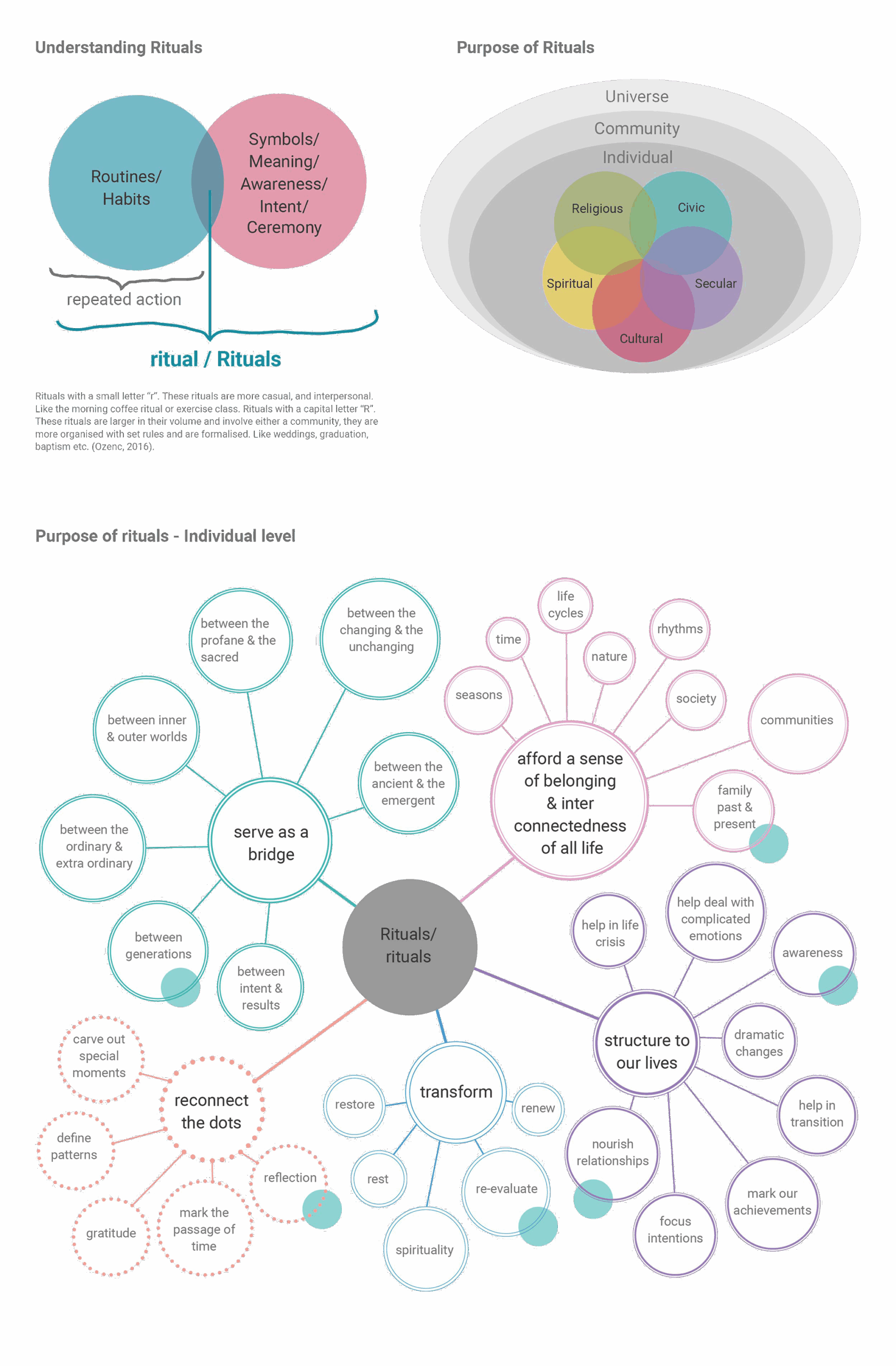
Van Gennep (1960) describes rituals in terms of “rites of passage” where the ritual’s performance allows one to make the change from one social status to another through setting, performance, sequences, repetitive action and structures.
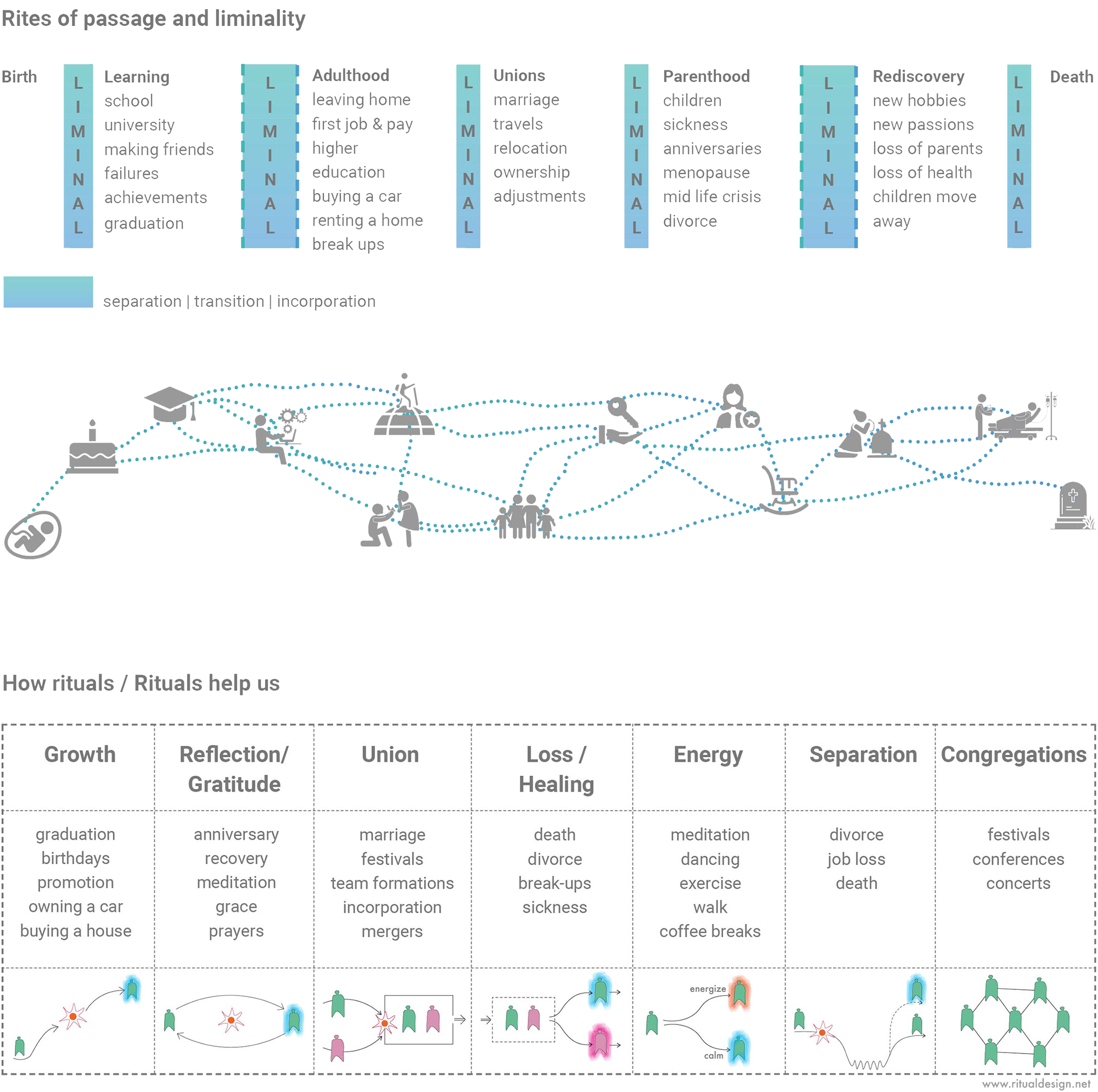
Contemporary individuals encounter issues of “change” all through life and rituals in its core help suspend the ordinary for a certain time and reconnects one with what is important and how life is meaningful. While doing so people identify with a story that’s told before or create their own story.
Primary Research
Process
Interviews, 5 Why’s, Probes, Online Engagement Tools, Co-creation Workshops.
Considering the lockdown and its effects on people, I wanted to talk to people about memorable celebratory events in their life which brought happy memories and took them back in time. I used weddings ceremonies as the ritual performance to explore the theme, given its importance in people’s lives.The five whys were used to get a glimpse into values.
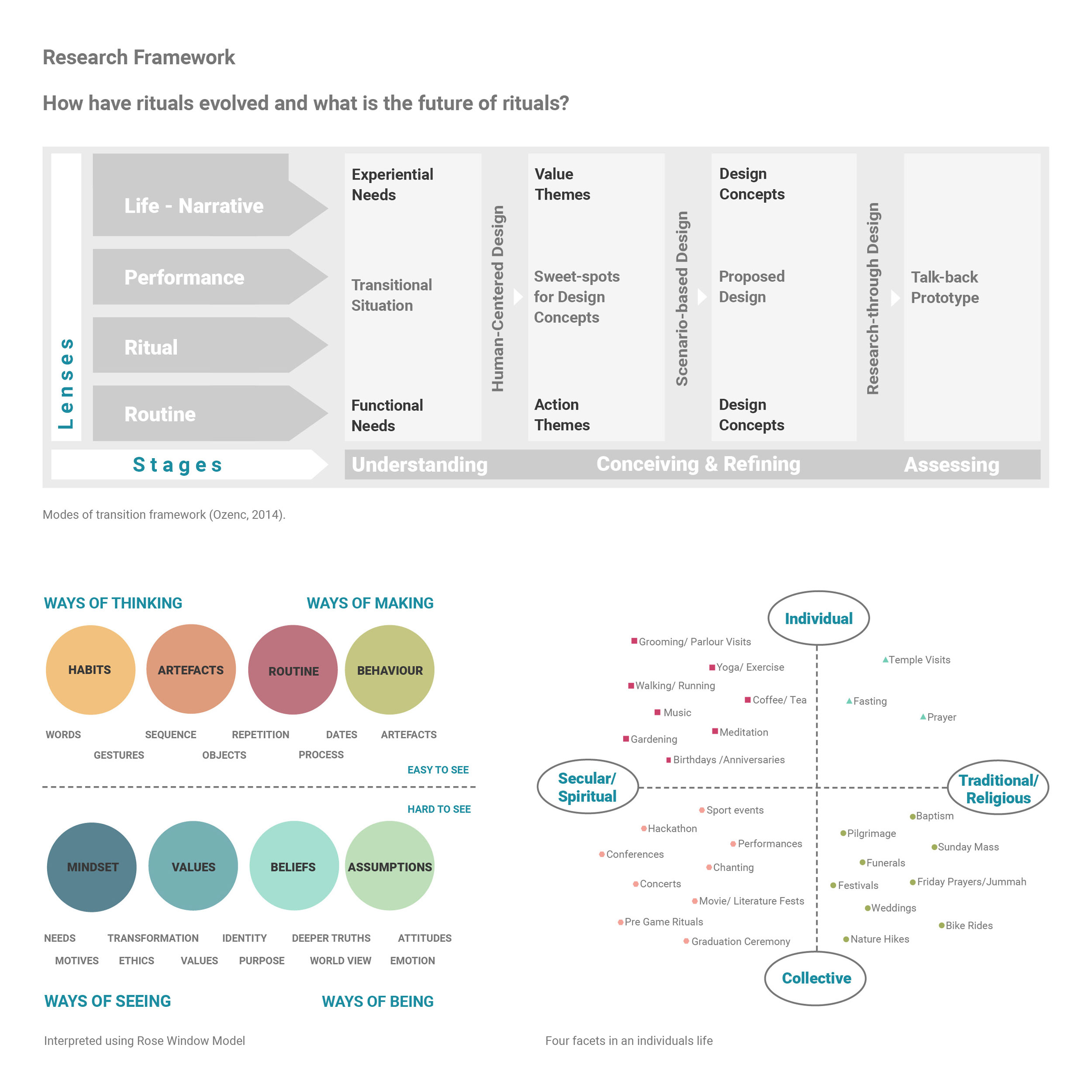
“I hated every part of it because it was very traditional. But I will still want to have a traditional wedding because that is what I have seen growing up and it is ingrained in me.”
“We have decided after the big wedding, now even when we have kids we will have small celebrations for them.”
“The clothes and the gifts were the most wasteful part of the wedding. The gifts didn’t fit our lifestyle.”
“We spent a lot of money on our wedding yes, could we have used the money better – yes… but the memories I got in return are priceless.”
“The clothes, bridesmaid dresses are not a waste – that is tradition, culture, memory. Two trees were cut for our wedding decoration – that was a waste.”
How Might We
(HMW)

The value of things change as people go through life. They don’t their children to repeat the same mistakes. They want to transfer evolved values and leave a better legacy for them.
Insights

Rituals and traditions are important to people even if they don’t fully understand them.
How Might We
(HMW)

Most of them couldn’t remember the gifts they received because commodities holds less value for them, yet gifting remains an important ritual in people’s lives.
Reflection:
Gifts in rites of passage or gifts as rites of passage
Gifts in rites of passage or gifts as rites of passage:
- Can the ritual of gifting be redesigned to be more meaningful?
- Is there a gap between what people want as gifts and what they receive?
- Should gifts help people to build a better future?
- Can the ritual of gifting on special occasions be a vehicle to transmit, and amplify values worth passing on through generations?
- What are the values that they want to bring from the past? Values that matter now and Values that are not formed yet, but driven by future expectations?
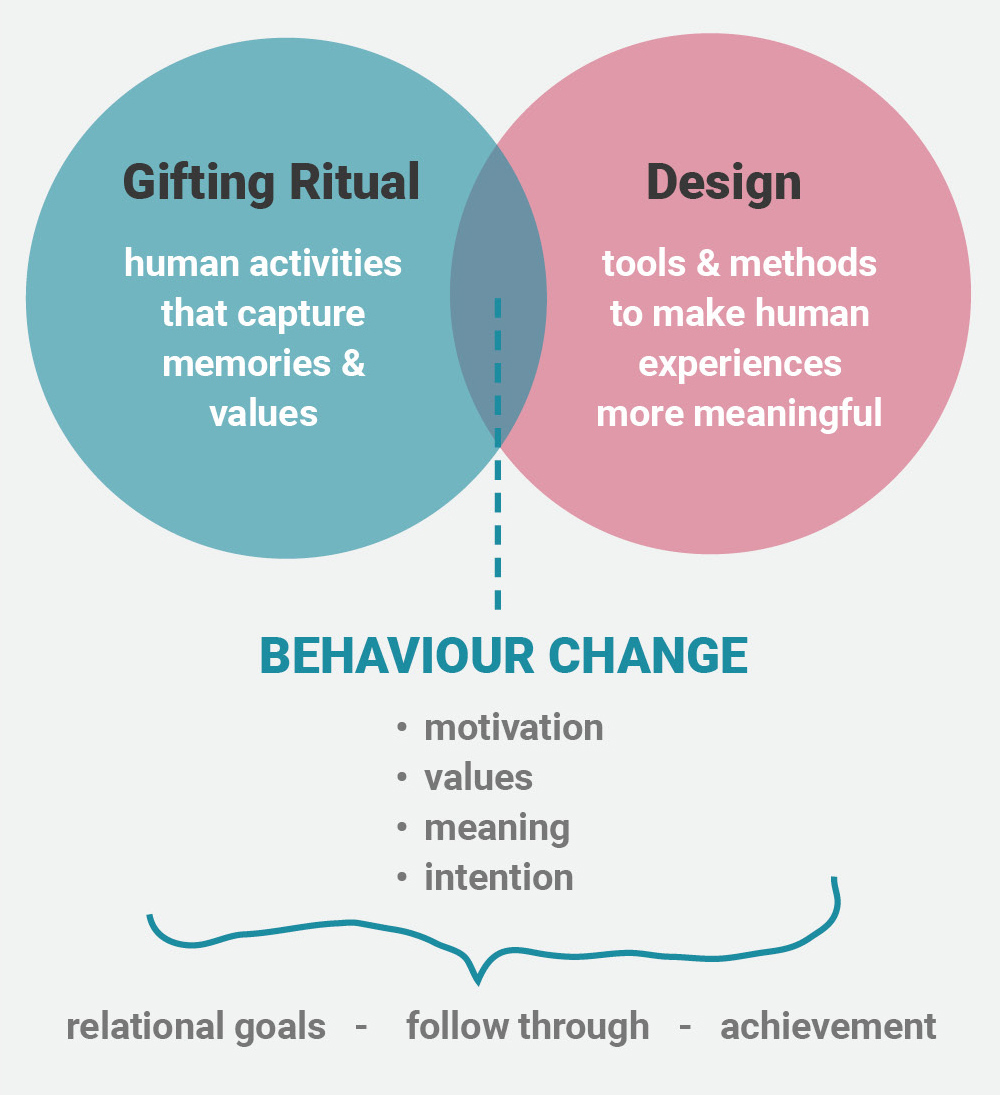
How Might We
(HMW)

Emotional Touchpoint
Rituals reconnects one with what is important and meaningful.
How Might We
(HMW)

Business Model
Transfer evolved values and leave a better legacy
How Might We
(HMW)
Service Strategy
Build and ecosystem and long-term engagement
HMW encourage a shift in behavior from present-day comforts towards behaviors whose impact will be visible only to future generations?
HMW encourage parents to make investments in their children’s futures based on their energy behavior/consumption patterns of today?
HMW develop alternate financial strategies in the gifting ecosystem?
HMW encourage parents to gift value-based gifts instead of commodities?
HMW encourage young adults to ask for gifts that help the environment in the long run?
HMW redesign the ritual of intergenerational gifting to pass on values, knowledge, and giving back to the future generations?
Online Engagement Tool
An important insight from the earlier interviews was around the lack of valuable and memorable gifts. I wanted to further explore how one could make gifts meaningful and memorable, especially in the intergenerational context (narrowed to parent-child for a more targeted group).
Participant Selection
I selected families as participants who have lived, or experienced different cultures from their native culture. The upper-middle urban families may have the luxury of living a greener lifestyle. 8 families were interviewed that spanned from ones living in Dubai (from India) (4), Glasgow (from America) (1), Ottawa (from Italy) (1), Los Angeles (from India) (1).
“It takes me back to my childhood – when I was happier. I have had it for 45 years now. It is the symbol of my youth in another county”
“When I moved to Canada my aunt gave me a fishing rod for my birthday. I fell in love with fishing. It was my connection to nature.”
“We went to Rome for her 50th birthday. She wanted to jog there for 50 minutes. We will always remember this – the smell of the day, the sun, the feeling.. everything.”
“I got a timeshare once, which I thought I won’t like… But I ended up loving the gift.”
“Most gifts are still commodities because it is easy.”
Intent / Desire Action Gap:
People want to move away from gifting commodities. However, they still do so because it is easy.
Analysis, Synthesis & Insights
The younger generation had a very fresh take on what could be a “cool” gift. They were interested in stocks and bonds of a company that their parents trusted. They were also more conscious of how products are sourced and were educating their parents about it. Together both the generations wanted to create new memories, learn new ways of doing things, leave a legacy / make an impact.
Insights
Before I started designing a solution, I enlisted the common values of the participants that were coming through the research methods – to reframe the How Might Wes.
Both generations want to create:
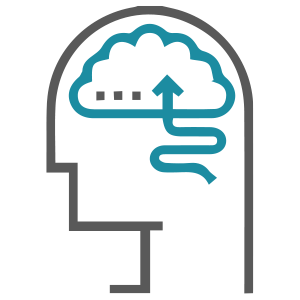
New Memories

New Values
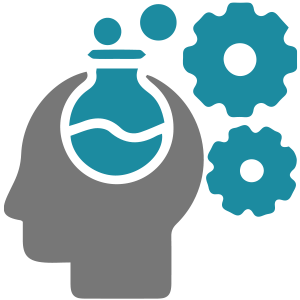
Ways to Self-Sustain

Ethically Sourced
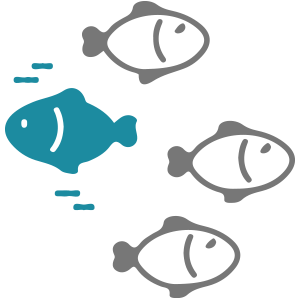
New Ways of doing things
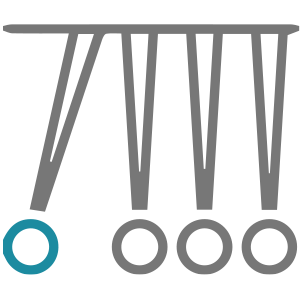
Legacy / Impact
Re-defining the
HMW
HOW MIGHT WE redesign the ritual of intergenerational gifting to urban young adults (18-25years) that gives them a chance to invest/gift a greener future?
Validation and Co-Creation
I conducted online co-creation workshops, to validate my finding & to gauge how services could be made more tangible for the user. How would they want to experience a gift which is not tangible, nor an experience, nor gives you instant gratification?
I conducted online co-creation workshops, to validate my finding & to gauge how services could be made more tangible for the user. How would they want to experience a gift which is not tangible, nor an experience, nor gives you instant gratification?
Process
Participatory Design, Co-Creation Workshops, Secondary Research, Back-casting, Trends, Talk to Experts
Participant Selection
I tried the workshop on three friends/students (22-25 years) which was a good starting point to gain insights on how youngsters view digital or intangible gifts. To understand the intergenerational relationship I conducted a second workshop with a family (parents and their son – 25 years).
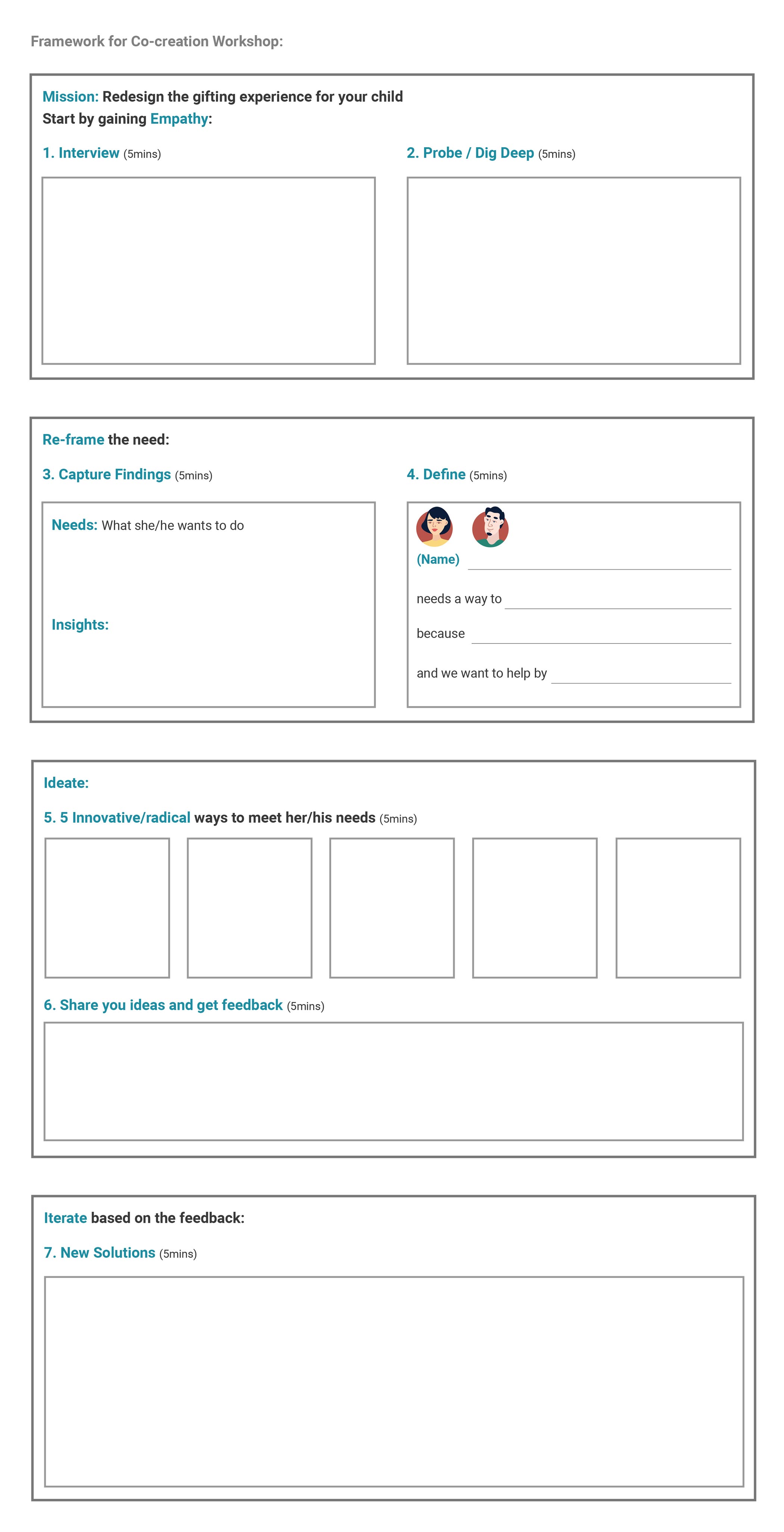
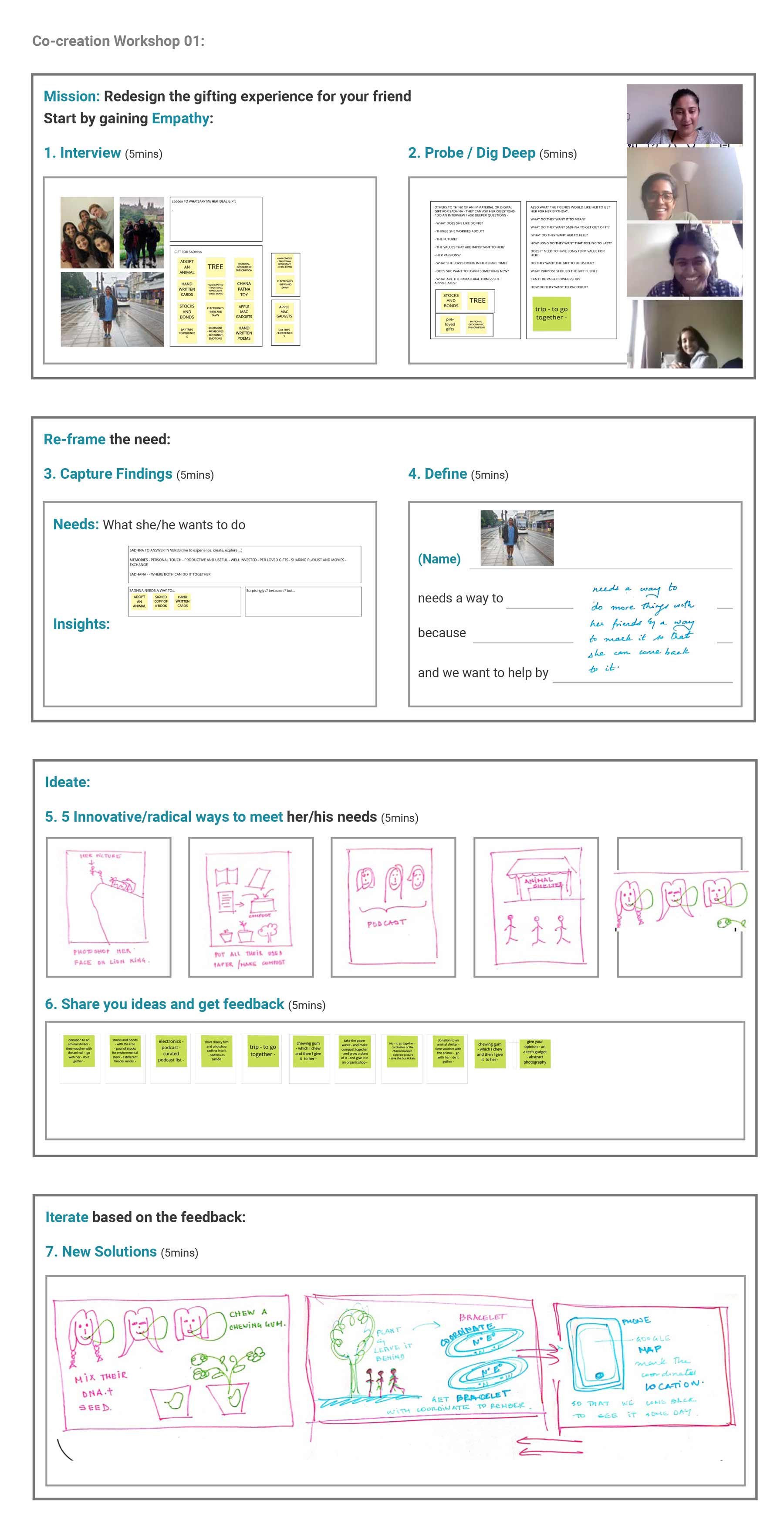
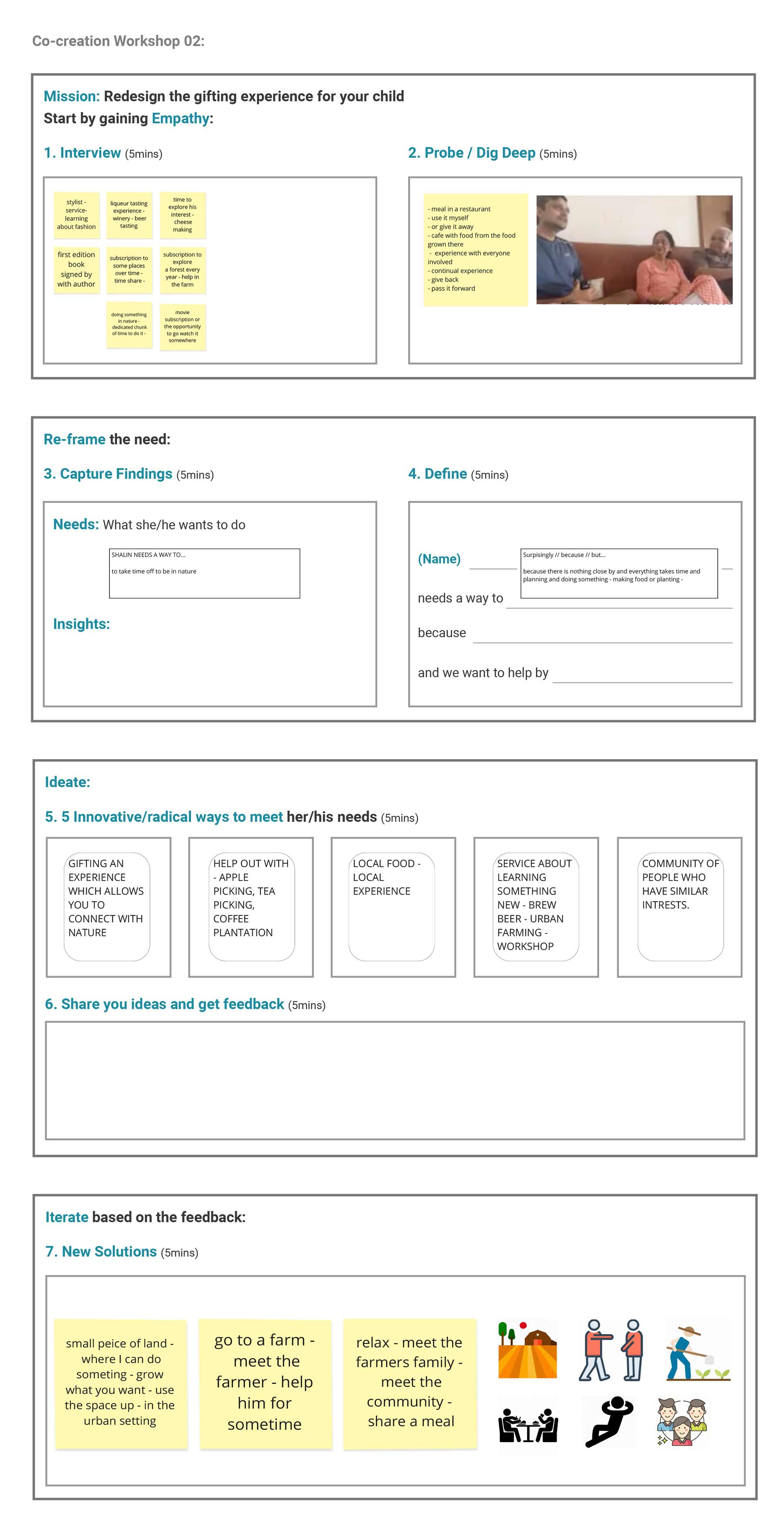
Evolution – Trends – Future of Gifting
I tried to do a back-casting to see the trends/signals. There seems to be a trend of gifts going digital. An emphasis on health, well-being, self-monitoring, and towards good causes.
Talk to Experts
“The idea of gift and sustainability is strong because of the emotions and values attached. Micro investment model in sustainability will have a tenfold impact on the universe. I would like my kids to have this head start.”
Hemant Julka (Co-founder & COO – VeggiTech)
“I started SUGi because I wanted to plant a tree on my birthday and invest in nature. The biggest challenge for me is that people still want stuff.”
Elise Van middelem (Biodiversity Builder & Founder – SUGi)
“The biggest problem is the gifting experience – the digital way to open a box and experience the surprise of a gift.“
Bas Fransen (CEO – EcoMatcher) & Alvin Junianto Lan (Technical Director)
”There is a rise in people asking to invest in green and sustainable causes close to their values, but he rather have them play it safe. It’s an extremely niche market and for vegans or environmentally conscious people.”
Rohinton Unani (Independent Financial Consultant)
Design Values & Process
Before I started designing a solution, I enlisted the values that I wanted the service to reflect, what I want people feel when they interact with my idea, and what contribution it could have to their lives.

Design for Collective Individual Power

Create Value not only in the Present but also in the Future
Design for the good of the Environment & Circularity

Inspire Long-term Goals & Engagement with the Service

Encourage people to be better Ancestors & leave a Positive Legacy

Design to have a Positive Ripple Effect
Design Process
Double Diamond Design Thinking Process
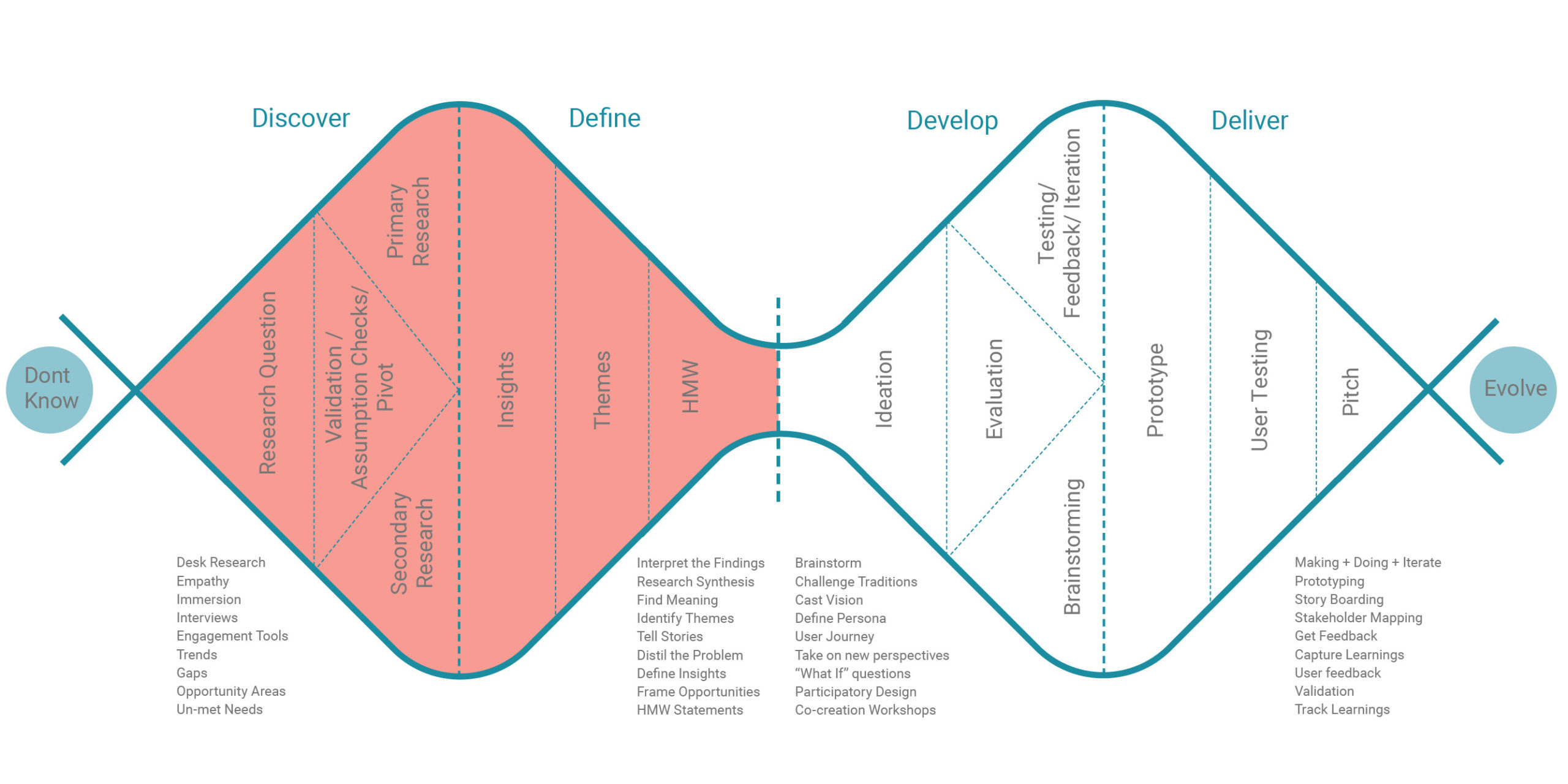
Concept Development
Process
Persona building, scenario cards, user reaction & validation.
Coupled with my initial motivations and interviews, online engagements, co-creation workshops, expert advice I made four rough persona’s and design options and concepts to gauge people’s preferences, reactions and their feedback. The aim was to grasp the: Preferred setting for the gift (local urban farm, rejuvenation of green urban projects, tree planting or reforestation), The preferred gifting model (subscription, single tree, trees per square meter, groups of trees), Extensions, and benefits (profit sharing, personal involvement, future visits and inheritance).
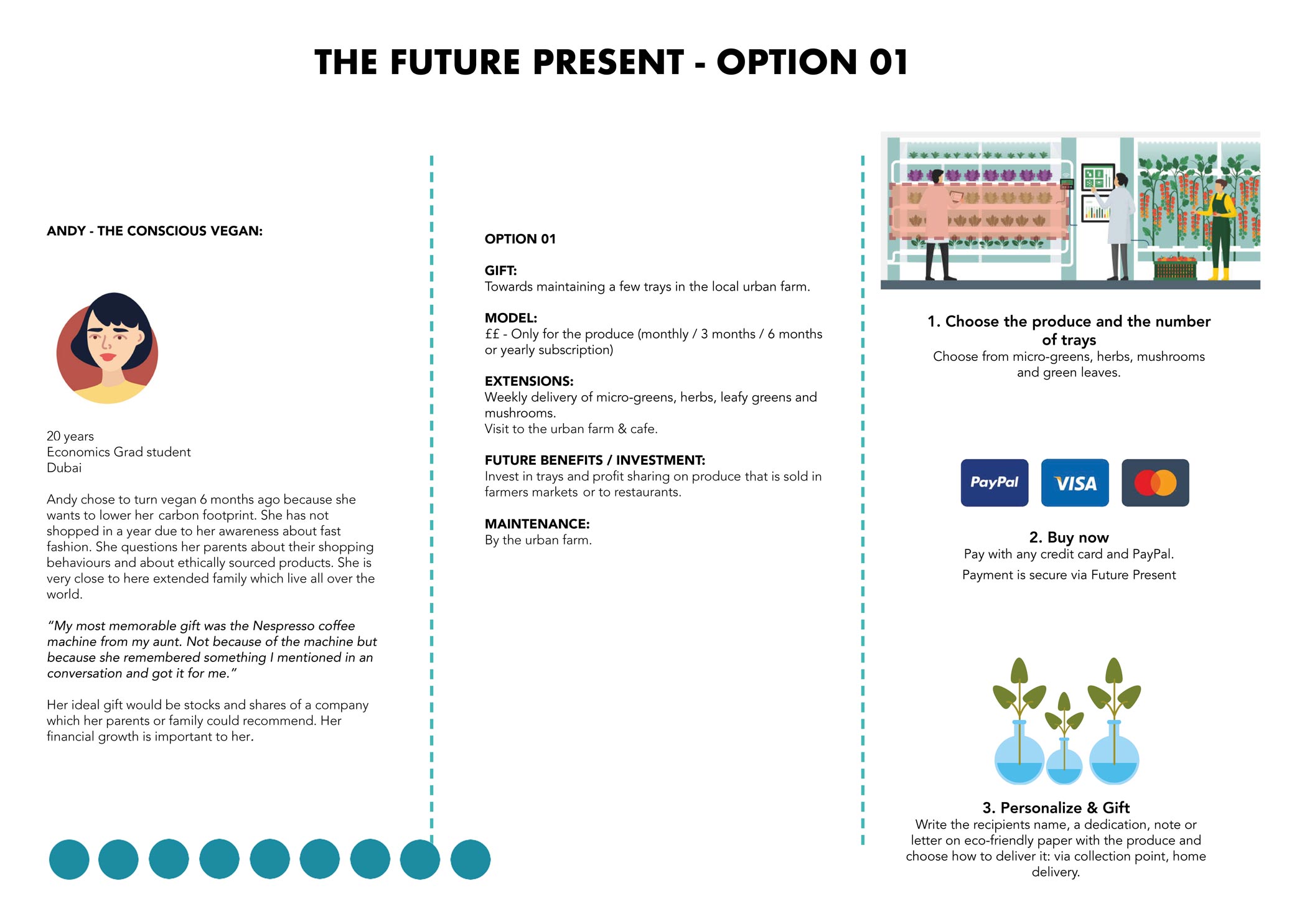
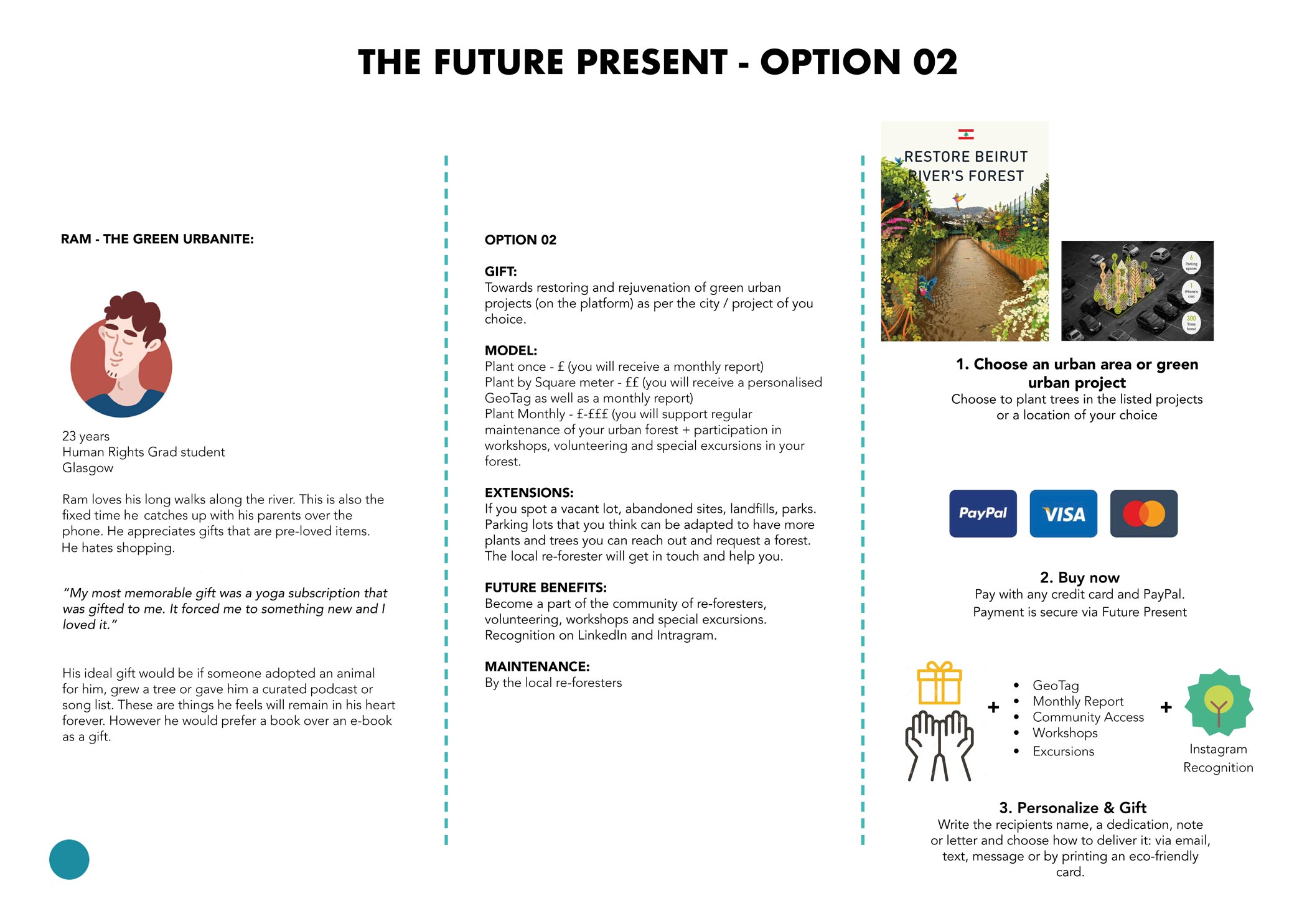
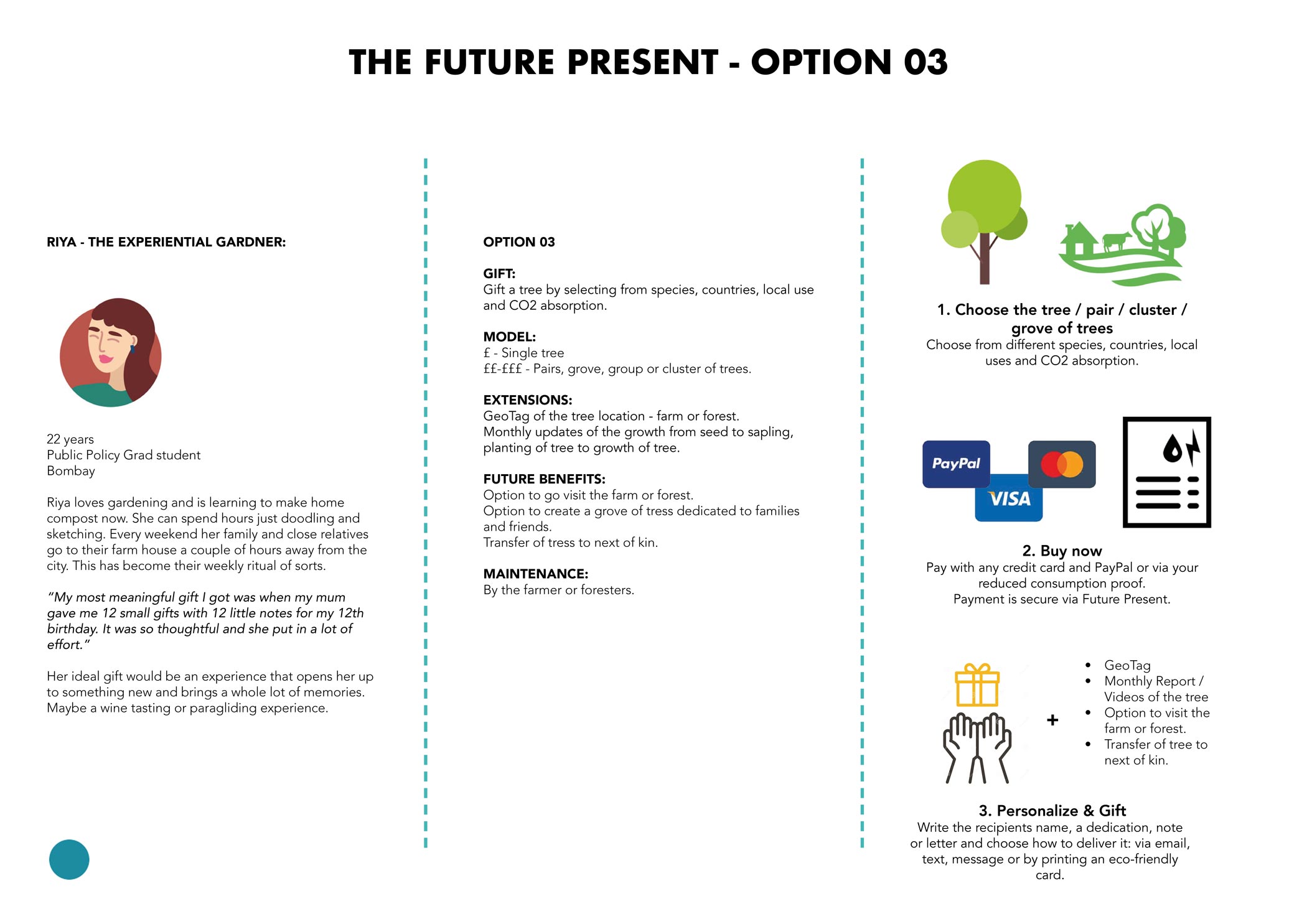

Key Findings
Values: People often remember gifts for their shared experience/connection/time
+
Trends: As people move away from commodities as gifts and to more experiential, digital, charitable, and environment-conscious gifts
+
Unmet Need: People want to move away from gifting commodities, but they still do so because it is easier
+
Opportunity: Lack of experience-based / engaging, and future positive investment options
Design
Process
User Journey Map, Storyboarding, Stakeholder Map, Prototyping
I envision the project taking shape of an online web/App-based platform/service that allows parents to make micro-investments for or on behalf of their children towards sustainable projects and package it as a gift. The initial starting point for the service is to collaborate with urban farming projects. As the platform develops, it can tie up with other sustainable initiatives as part of its service.
User Journey Map
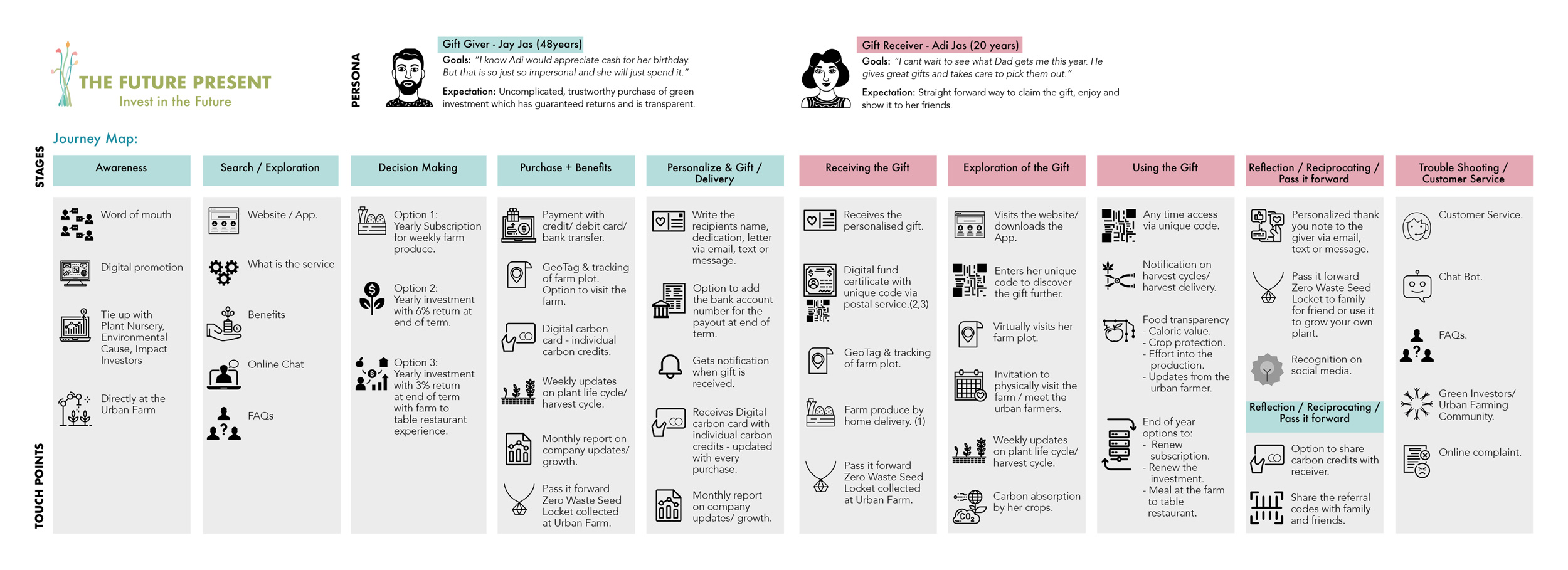
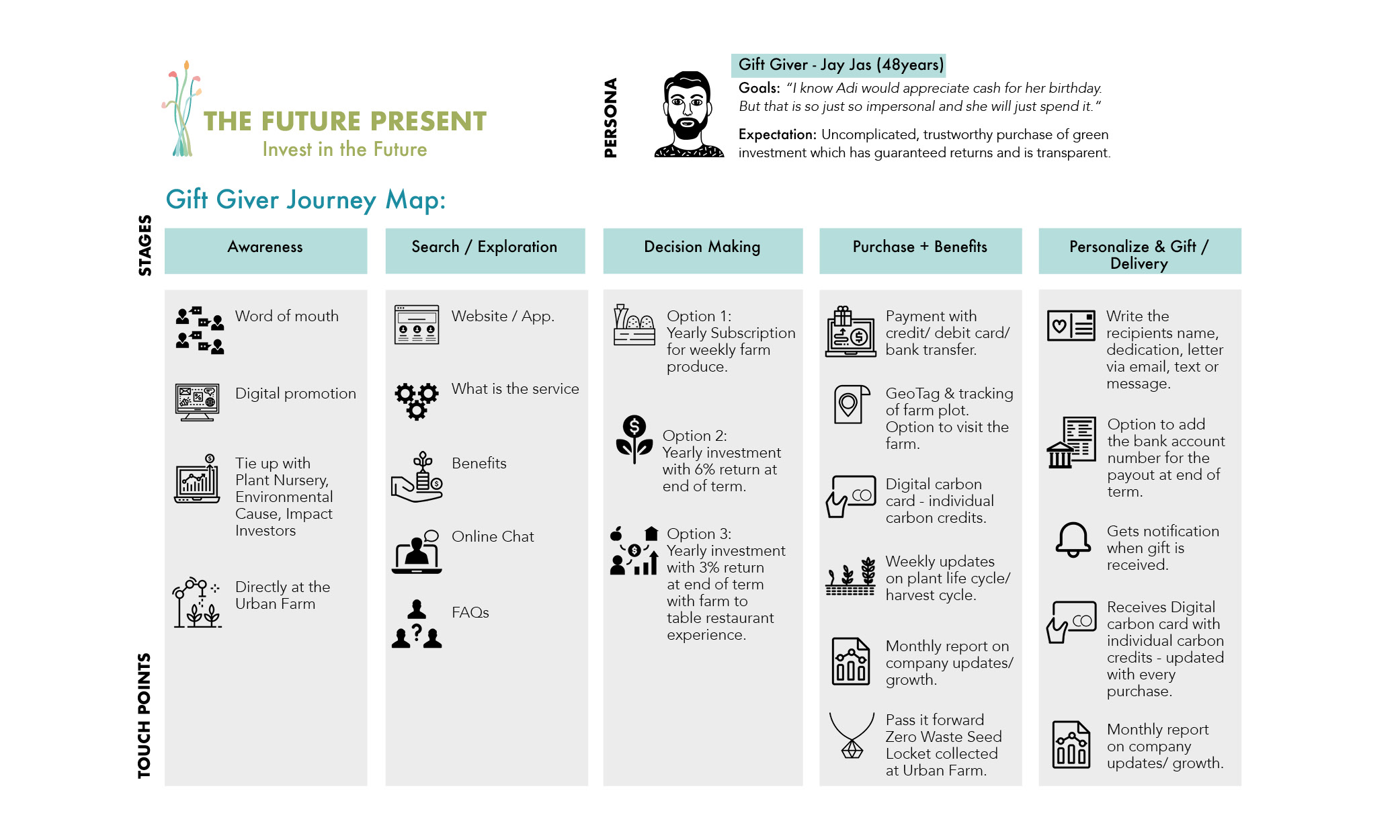
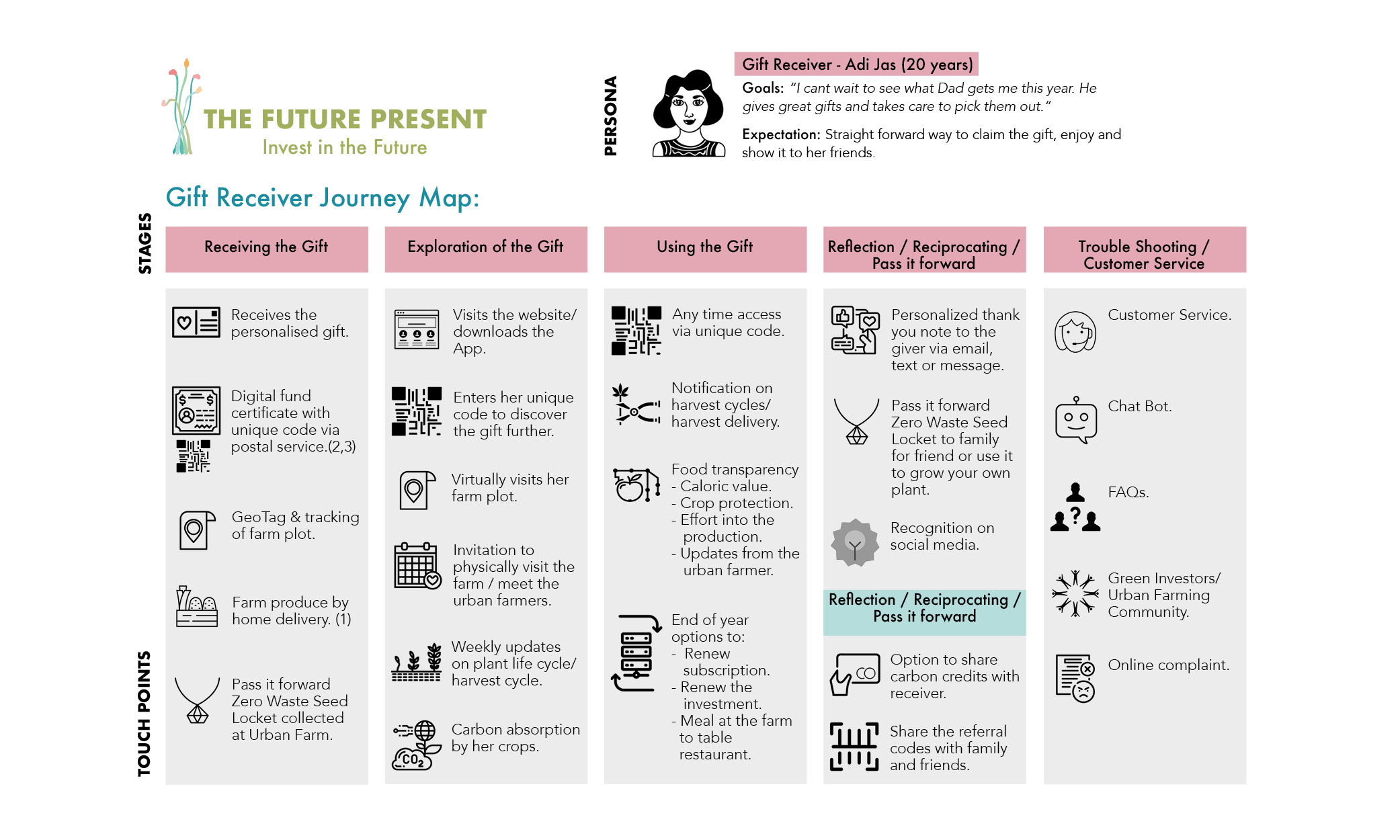
Storyboard
To get a better sense of how the service works, I designed a storyboard that explains how a gift giver and receiver would go about using the service, what touch-points would they need to interact with, and how they could keep being engaged in the service.
- The scenarios covered include:
- Exploring the service through its online touch-point.
- Opening a digital gift.
- Visiting the farm to be able to see your investment/gift.
- Feeling vested in the service by tracking various aspects of plant growth and its benefits.
- Using carbon credits.
- The magic of the seed locket
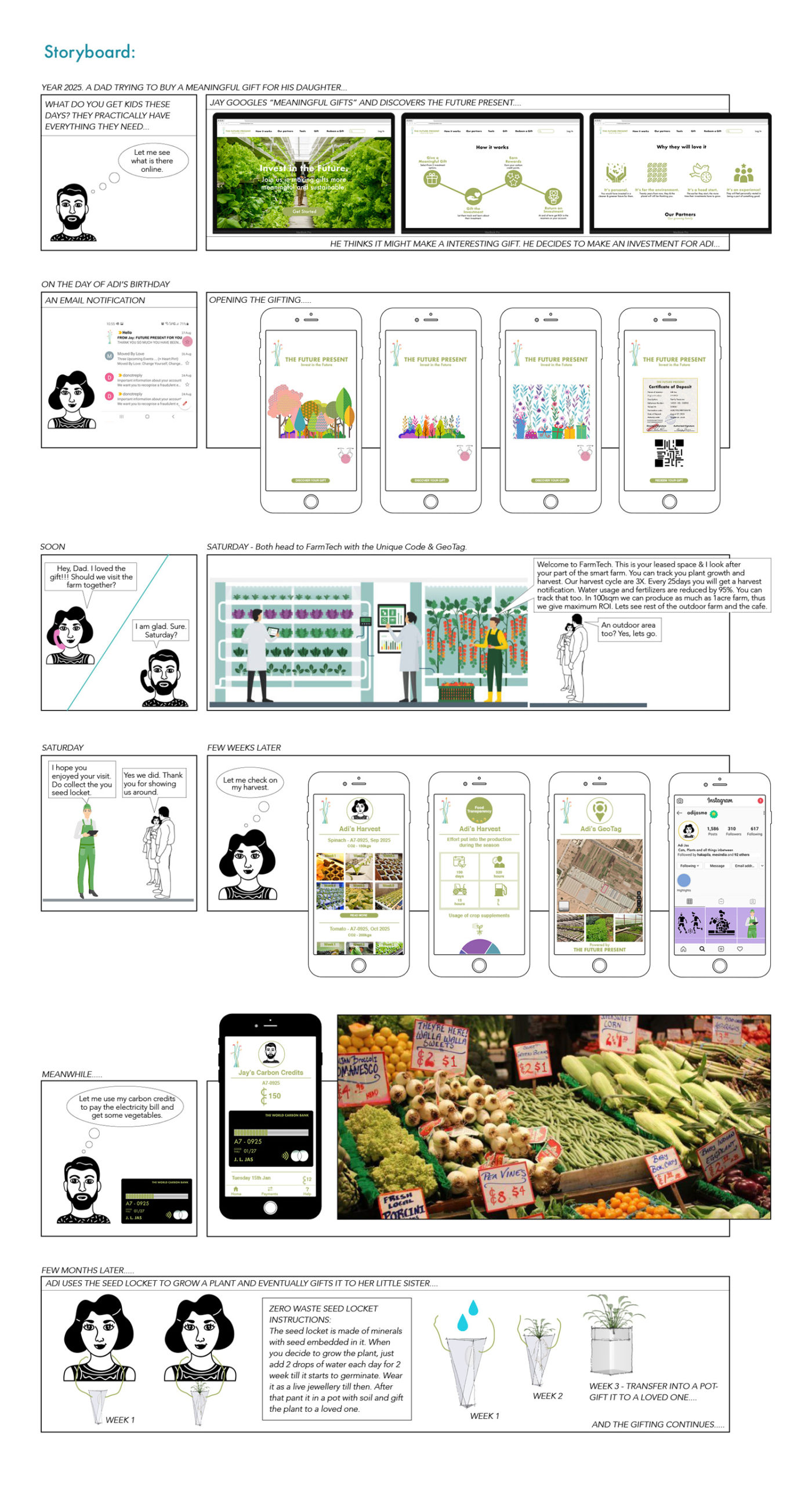
Touchpoints
Gift Giver: Introducing them to The Future Present via a website: explaining the service, investment options, the returns, minimum investment, the period, terms, and conditions. The carbon credits the giver receives: how these can be used now and, in the future, (paying bills, buying vegetables, sell-able to companies, carbon offsetting during flights), transferable within family members, and intergenerational transfer.
The carbon credits the giver receives: How these can be used now and, in the future, (paying bills, buying vegetables, sell-able to companies, carbon offsetting during flights), transferable within family members, and intergenerational transfer.
Gift receiver: The experience of digitally opening a gift: the digital element of surprise by swiping various screens to discover the gift – with the fund certificate and unique code.
Gift receiver: Food transparency: tracking of the harvest, the farm, the growth cycles, effort into the production, usage of crop supplements, crop protection added, and the nutrients.
Social media recognition: Green tree on Instagram for efforts towards environmentally conscious behaviour.
Reflection
Future Discounting: The What If… scenario showed a bleak future. If I had depicted a more optimistic future the insights could have been different. I might have missed the aspect of denial, future discounting, sense of powerlessness in the face of complex challenges like the environmental crisis.
Choice of Participants: The participants who have the option to be greener were selected. If it was a different selection the answers could be different. Some of the participants had their kids living separately, which might have created a bias on the importance of connection with them.
Intent-Action Gap: There is also an intent/desire–action gap. People might want to move away from gifting commodities, but they still do so because it is easier. Using the context of gift, I might have reached the emotional and social self and maybe less of the rational self.
Element of Surprise: How does one include the element of surprise, the joy of opening a gift, and the physical gifting experience in the digital space? This is an area worth enquiring into to make the intangible more tangible.
Take away: Service design uses a human-centric design method to make the intangible into the tangible through sequenced actions, touch-points, objects, and prompts. What if services like rituals could create the extraordinary out of the ordinary, add value to people lives, create

